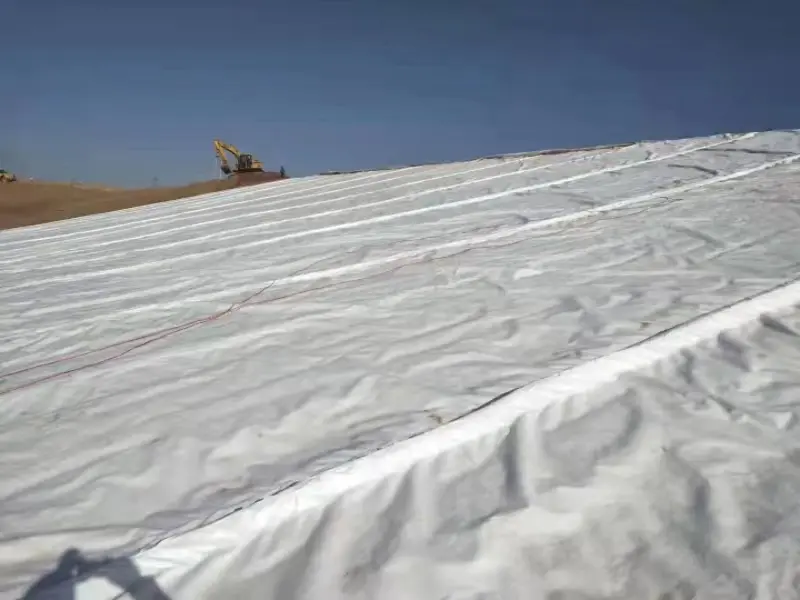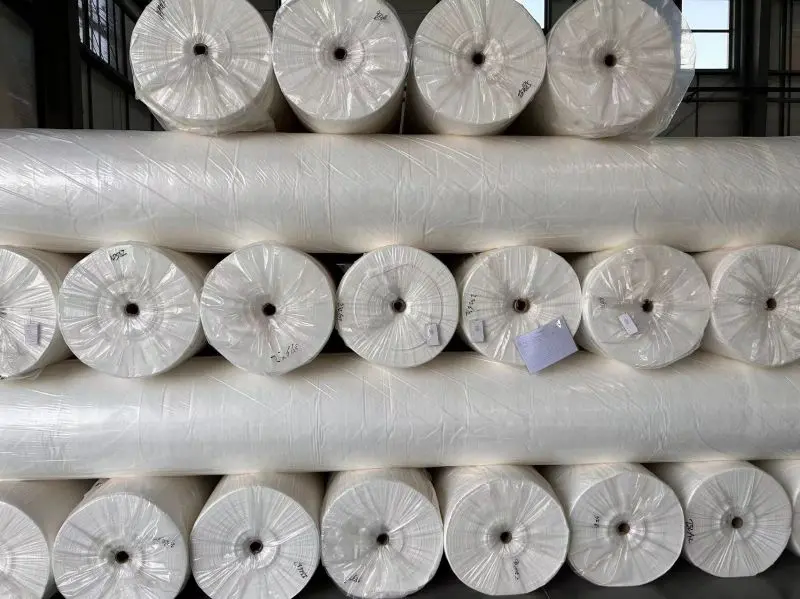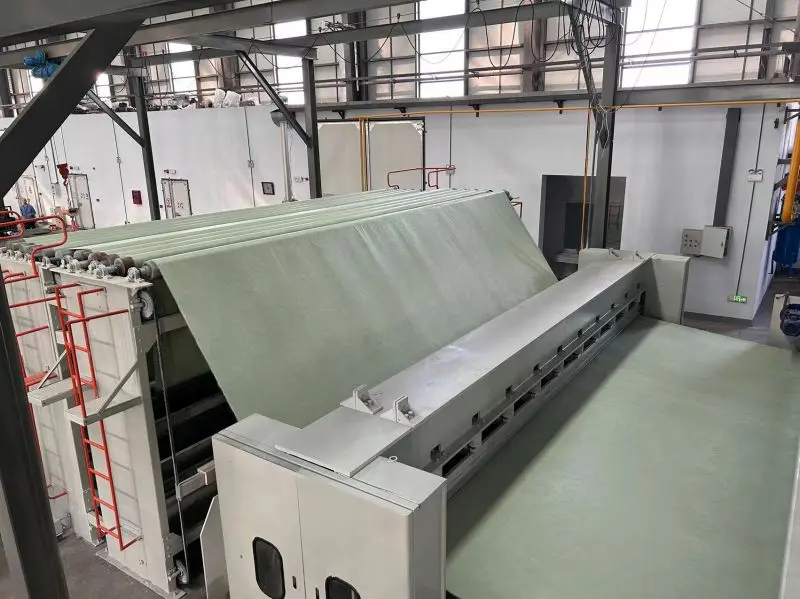
Product Performance
Possessing high strength, strong puncture resistance, acid and alkali resistance, corrosion resistance, microbial resistance, and aging resistance. PET Needle-punched non woven geotextile fabric exhibits superior water permeability, filtration, and soil retention, serving the functions of isolation, drainage filtration, and protection. With low cost, simple construction, and convenient usage.
Product funtions
373034.webp)
(1) Drainage Function:
PET Needle-punched non woven geotextile fabrics serve as porous permeable media that, when buried in the soil, gather water and facilitate its drainage from the soil. They can drain both vertically along their plane and horizontally, providing effective drainage for applications such as embankments, roadbeds, retaining walls, and consolidation of soft soil foundations.
(2) Filtration Function:
To prevent the infiltration of fine particles into the soil (piping phenomenon), traditionally, graded granular materials are used as a filtration layer. However, both woven and non-woven geotextile fabric can replace conventional granular materials, serving as effective filtration layers. In cases where high filtration requirements are not necessary, non-woven textiles are commonly chosen for use as filtration layers.
(3) Isolation Function:
In geotechnical engineering, the phenomenon of mutual mixing between layers of different granular materials often occurs, leading to the loss of their intended properties. Placing geosynthetic materials between different granular layers can provide effective isolation. For instance, in the construction of gravel sub-layers on weak foundations, the interlayer placement of geotextiles effectively prevents the interpenetration of soil materials, controlling uneven settlement. The isolation function of geosynthetic materials has proven effective in highway construction and the treatment of soft soil roadbeds.
(4) Reinforcement Function:
PET Needle-punched non woven geotextile fabrics possess high tensile strength and large deformation ratios. When appropriately buried in the soil as reinforcement, they can control soil deformation and enhance soil stability.
(5) Protection Function:
PET Needle-punched non woven geotextile fabrics can diffuse concentrated stress and transfer stress from one object to another, preventing damage to the soil under external forces. They are primarily used in river channel regulation, embankment protection, bottom protection engineering, coastal moisture prevention, and road slope protection projects.
(6) Anti-seepage Function:
Coating the surface of geosynthetic materials with a layer of resin or rubber, or combining geosynthetic materials with plastic films to form impermeable materials known as geomembranes, achieves anti-seepage effects. Geomembranes are often composed of thin non-woven fabrics combined with thin films, and can be tailored to specific engineering needs, such as one fabric to one film, two fabrics to one film, or three fabrics to one film configurations. The chosen thickness of the non-woven fabric and film can be adjusted as needed, providing both waterproofing and anti-seepage effects simultaneously.
Application for roads

The application of PET filament needle-punched geotextile fabric in road construction is extensive:
1, Road Base Reinforcement:
PET filament needle-punched non woven geotextile fabric is utilized as a reinforcement material in road engineering to enhance the stability and deformation resistance of the road base. By embedding this geotextile in the roadbed soil, it effectively disperses and bears traffic loads, reduces road settlement, and prolongs the lifespan of the road.
2, Drainage System:
The geotextile's water permeability makes it an ideal choice in road drainage systems. It can be used as a drainage material beneath the waterproofing layer, facilitating the rapid removal of rainwater and preventing water from infiltrating into the lower layers of the roadbed, thereby preventing softening and damage.
3, Soil Erosion Control:
PET filament needle-punched non woven geotextile fabric can be employed to prevent soil erosion. Along road slopes, retaining walls, and other areas prone to erosion, it serves as an effective protective layer, preventing soil scouring from rainfall and water flow and preserving the integrity of road structures.
4, Filter Layer:
In road structures, PET filament needle-punched non woven geotextile fabric can function as a filter layer, preventing fine particles from entering the soil and avoiding piping phenomena, thereby enhancing the stability and durability of the road structure.
5, Soft Soil Treatment:
In the treatment of weak foundation soils, this geotextile is widely used to reinforce and stabilize soft soil foundations. By burying it in soft soils, it increases soil strength, reduces settlement, and provides a more reliable foundation for the road.
Overall, the multifunctional characteristics of PET filament needle-punched non woven geotextile fabric, including high strength, strong puncture resistance, acid and alkali resistance, make it a crucial geosynthetic material in road construction, contributing significantly to optimizing road structures and enhancing performance.
Specifications we can supply:
| mass per unit of area | 100g/㎡-600g/㎡ |
| Width | ≤6.6m |
| Length | 50-100m or according to customized |
| Color | white, green, black or customized |
FAQ
1. What is PET non-woven geotextile fabric needle-punched filament geofabric, and how is it used in road construction?
PET non-woven geotextile fabric needle-punched filament geofabric is a type of geosynthetic material made from polyester (PET) fibers through needle-punching processes. It is extensively used in road construction for applications such as road base reinforcement, drainage, and soil stabilization.
2. What are the key characteristics that make PET non-woven geotextile fabric suitable for roads?
This geofabric exhibits high strength, strong puncture resistance, acid and alkali resistance, and durability. Its unique composition and manufacturing processes contribute to its effectiveness in applications requiring filtration, drainage, and soil protection in road construction.
3.How does PET non-woven geotextile fabric contribute to drainage in road construction?
The fabric's porous structure allows it to act as a drainage medium, collecting and channeling water away from the road structure. This not only prevents waterlogging but also helps in maintaining the integrity and stability of the roadbed.
4. Can PET non-woven geotextile fabric be used for erosion control along road slopes?
Yes, PET non-woven geotextile fabric serves as an effective erosion control measure. When installed along road slopes, it acts as a protective layer, preventing soil erosion caused by rainfall and water flow and preserving the structural stability of the road.
5. What are the advantages of using PET non-woven geotextile fabric in road construction compared to traditional materials?
PET non-woven geotextile fabric offers several advantages, including cost-effectiveness, ease of installation, and convenience in use. Its ability to provide reinforcement, drainage, and filtration in a single material makes it a preferred choice over traditional materials in many road construction applications.
409.webp)

834.webp)



503.webp)
759.webp)

597.webp)
411.webp)